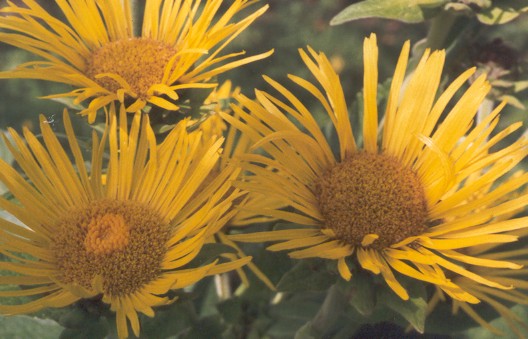(Inula heminum)
The plant's specific name, helenium, derives from Helen of Troy; elecampane is said to have sprung up from where her tears fell. It was sacred to the ancient Celts, and once had the name "elfwort".
-also called wild sunflower scabwort, and horseheal, is a perennial garden flower traditionally used to kill intestinal parasites and treat bronchial congestion. Traditional Chinese and Indian Ayurvedic medicine recommends elecampane for treatment of bronchitis and asthma. Elecampane is also said to improve digestion, and has been used for many years to heal skin infections in horses and sheep.



Part used: root
Properties: cholagogue, diuretic, expectorate, stomachic, asteingent, stimulant.
What it affects: lungs, stomach and spleen.
Preparation and amount:
Infusion: steep 15-30 min and take 1-2 cups daily in a hot or cold preparation.
Decoction: simmer 15-30 min and take 1 tbsp as needed or 1-2 cups every day
Tincture: take 30-60 drops (1/2-1 tsp) 1-2x every day.
Fluid extract: take 1/2-1 tsp, 1-2x a day.
Power: take 3-10 #0 capsule(20-60 grains) 1-2 x a day.
Purposes:
Internally, elecamoane tea is frequently used to quiet coughing, to stimulate digestion, and to tone the stomach. It is useful for all respiratory problems, including bronchitis, urinary and respiratory tract inflammation. For chronic lung ailments, combined with wild cherry bark, white pine bark, comfrey root, and licorice. The oil is the best for treating respiratory and intestinal catarrh, chronic diarrhea, chronic bronchitis, and whooping cough.
Elecampane promotes expectoration and is good for whooping cough, weak digestion, and poor assimilation. the decoction taken in 1 tbsp. dosages will counteract stomach poisons and increase digestive power. The Chinese use it to counteract ingested poisons..A decoction is made using 1 oz. of the root, simmered in a pint of water for 1 hour, then taken in doses of 2 tsp. as needed. The powered root is taken in doses of 2 tsp as needed. The powered root is taken in capsule (1 capsule) or 1/2 coction or tincture also dose, 3 x every day. The decoction or tincture also expels worms. When combined with echinacea, it is good for tuberculosis.
Externally, elecampane can be used as a wash or fomentation for skin problems, such as scabies, itches, and skin diseases.
| Plant DescriptionIt is a striking and looks handsome plant. The erect stem grows from 4 - 5 ft' high, it is very stout and deeply furrowed, and near the top, branched. The whole plant is downy. It produces a radical rosette of enormous, ovate, pointed leaves, from 1- 1 1/2 ft' long and 4 inches broad in the middle velvety beneath, with toothed margins an borne on long foot-stalks; in general appearance the leaves are not unlike those of Mullein. Those on the stem become shorter andrelatively broader and are stem-clasping. The plant is in bloom from June to August. The flowers are bright yellow, in very large, terminal heads, 3- 4 inches in diameter, on long stalks, resembling a double sunflower. The broad bracts of the leafy involucre under the head are velvety. After the flowers have fallen, these involucral scales spread horizontally, and the removal of the fruit shows the beautifully regular arrangement of the little pits on the receptacle, which form a pattern like the engine-turning of a watch. The fruit is quadrangular and crowned by a ring of pale-reddish hairs - the pappus. The plant springs from a perennial rootstock, which is large and succulent, spindleshaped and branching, brown and aromatic, with large, fleshy roots. |
No comments:
Post a Comment